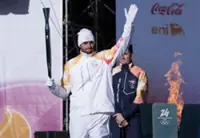FILE PHOTO: Paris 2024 Olympics - Hockey Training - Yves-du-Manoir Stadium, Colombes, France - July 25, 2024. Netherlands coach Paul Van Ass with players during training. REUTERS/Adnan Abidi/File Photo
PARIS (Reuters) - The Netherlands' top women hockey players can appear unstoppable at times as they sprint up and down the pitch with apparent ease, not showing the kind of fatigue other teams do in the heat and humidity.
But their secret is actually hidden in plain sight, strapped across the chest or on the outside of the arm, as they use a half century-old technology to better monitor fitness and fatigue.
Through a combination of biometric data from both heart rate monitors and GPS trackers to get readings on effort levels, the Netherlands coaches can build specific exercise and recovery regimes on a player-by-player basis.
"It's important because you read your cumulative fatigue, and if your heart rate is coming down in your aerobic zone and you go back, that's good," the Netherlands women's coach Paul van A** said.
"But if it's not coming down anymore in your aerobic zone, then you get cumulative fatigue. We try to prevent that. We train to make zones longer and longer and lower and lower."
Van A** said he first implemented the heart rate approach to training when he coached the Netherlands men's side on their way to the London Olympics, where the team won silver after a disappointing blowout loss in the bronze medal match in 2008.
"It is mostly for determining training. At game time, we look at the real figures. How is a match for your body? And can we adjust or do we have to adjust our training methods or intensity? That's what we do."
If an athlete is having a hard time adjusting or lowering their heart rate back into either the aerobic or recovery zone, it often means that fatigue has accumulated to a point that rest and recovery should be prioritized.
"Nowadays, you have this GPS system. It's just how many meters you run, and what is your sprinting distance, and what is your total distance. And the rest of the world skipped the heart rate and transferred to this. And we did both."
Runners also often use both distance tracking and heart rate in ways that can be broken down to track fatigue development at different sections of training sessions to allow them to adjust their workout or recovery sessions.
"Now I get better data, of course, because now I know how many sprint metres do you run, and how do you recover from that, and I can see that in your heart rate," said van A**.
(Reporting by Forrest Crellin; Editing by Hugh Lawson)





